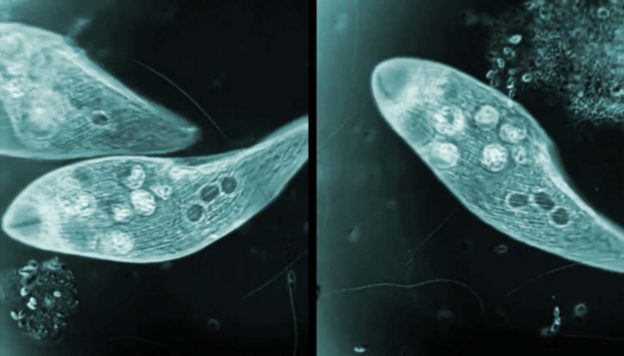This research project is in line with my previous work that combines art and science to reconnect people with living nature. I want to stimulate wonder, respect, and care for living beings so that humanity as a whole refocuses its life styles on creating a sustainable world rather than a world ravaged by climate catastrophes, polluted to such a level that it harms or kills living beings on a massive scale, and filled with conflicts and antagonisms due to the unavoidable competition for the shrinking resources of our precious planet.
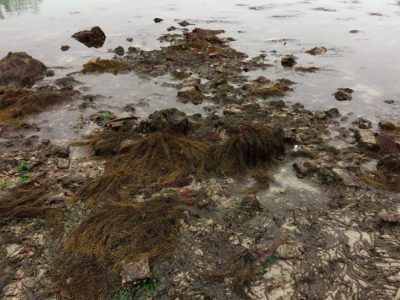
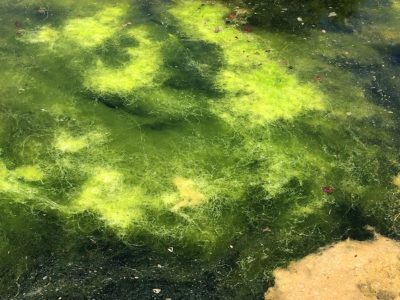
Left: Algae at low tide in the Venezian Lagoon. Right: Thin, hairlike Algae (Spirogyra) in a pond in Venice.
©AnneMarie Maes, 2019
In earlier work I focused mostly on integrating tools from electronics, the internet, data processing, and AI into my artistic practice, alongside traditional methods such as drawing, sculpture, photography and video, in order to make the invisible activities of living beings visible.
The past years I have been shifting my focus more and more on integrating tools from biology, biochemistry, biotechnology and materials science, still in tandem with more traditional artistic methods. My aim is still the same: draw attention to the precarious state of the living world, but I am now looking at colonies of micro-organisms which are even more invisible but nevertheless enormously important for the sustainability of the ecosystems on which human life depends. I focus in particular on marine ecosystems and the algae that thrive in them. I will study the micro & macro algae as well for their possibilities as new organic materials (materials science), as for their bio-technological and bio-chemical qualities to monitor climate change and air/water pollution. I will take a deeper look as well into fascinating symbiotic organisms as lichen (fungi and algae), corals and sea sponges.
Algae are a divergent group of eukaryotic organisms that live in or near the water. They range from very small unicellular microalgae to multicellular forms like kelp to very big seaweeds. Cyanobacteria are strictly speaking not algae because they are prokaryotes, i.e. they do not have a nucleus. But they are often classified as blue-green algae and are therefore included in my artistic project.
Algae form the energy basis of the complete food web for all aquatic organisms and are therefore crucial for our own food supply. They are also increasingly used as direct sources of food (particularly in Japanese-inspired cuisine) and they have applications for cosmetics, replacements for textiles, renewable energy, and many more.
Translating the fascinating world of algae into exciting art works and exhibitions is a big challenge.
A collaboration with science provides inventories of earlier forms of living systems and their evolution, which I often use as a start for developing my artistic research. I assemble a close reading of the fascinating world of algae and cyanobacteria through aesthetics from bio art and eco-technologies, with a focus on sensory experiences and materiality in my artistic methodologies. I combine the results of my field work and experiments into installations that bring together algae specimens, cyanobacteria cultures, bacterial grown skins, DIY bioreactors and much more. Such assemblages can be experienced as cabinets of curiosities which the viewer is invited to discover. Each of the objects is precious and draws admiration and amazement from those who care to look. The overall impression one gets is that a new world opens up and people begin to see aspects of nature in a new light.
2020: Study of macro algae – Laguna of Venezia, Adriatec Sea, North Sea. Focus: biodiversity research.
Naturalism is the study of the natural world as a whole and the study of each species within its environment, as well as how species interact with each other. I take a naturalist approach to start this macro-algae research. A naturalist is a type of biologist who studies the impacts of living species on each other and the environments in which they live. I study the different elements of the Venetian Lagoon and how they relate to each other, to get a better insight in the dynamic network of this ecosystem. Evolutionary science is at the core of the naturalists’ work, which is very much about observations in the field next to the work in the lab.

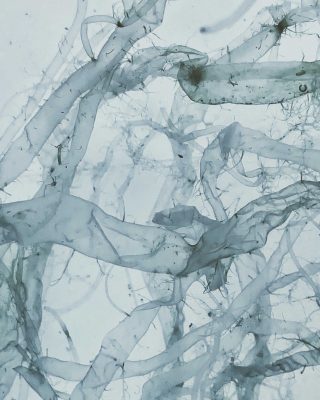
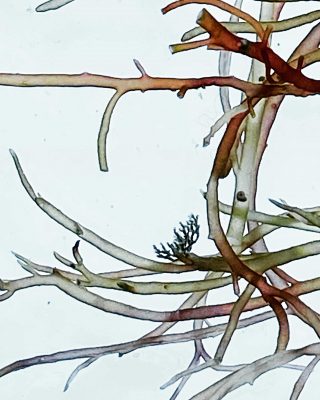
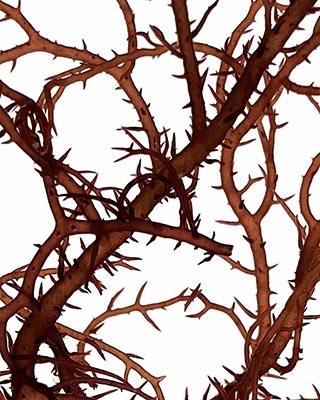
Live and healthy specimens were collected along the coast of the Venetian Laguna, at the island La Certosa, and at the Adriatic sea coast of the Lido di Venezia, during low tides in the month of June 2020. photo ©AnneMarie Maes

Dried algae, collected in 2020 at the North Sea coast, in the Venezian lagoon and at the Adriatic Sea (coast).
Presentation Boxes 66cm x 50cm x 6cm, plexiglass & forex. ©AnneMarie Maes
2020: Bacterial Life in a Winogradsky Column
A Winogradsky column is a device for culturing a large diversity of microorganisms. The transparent device is filled with mud from my rooftop (soil, compost/soil) and rainwater mixed with a carbon source containing cellulose, with egg-shells containing calcium carbonate, and with a sulfur source such as gypsum or egg yolk, containing calcium sulfate. Incubating the column in sunlight for months (in the greenhouse) results in an aerobic/anaerobic gradient as well as a sulfide gradient. These two gradients promote the growth of different microorganisms: species of bacteria, cyanobacteria, and algae.
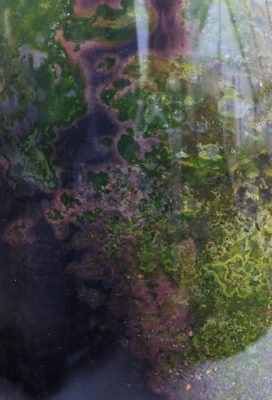
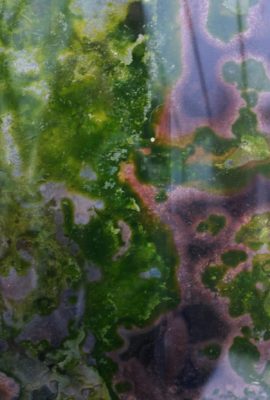

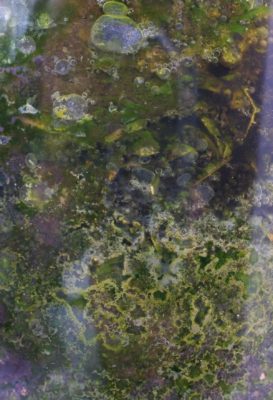
Winogradsky colums started March 2020 finally are showing bacterial results! The columns are set up with mud from my rooftop and/or compost, with shredded newspaper, egg yolk & egg shells, plaster dust and topped with rainwater. The colums were standing for months in my greenhouse, waiting for microbial life to develop … ©AnneMarie Maes
2019: Study of micro algae at the Hybrid Forms Lab (VU Amsterdam) & Open BioLab Brussels (Erasmus Hogeschool). Focus: Applied Photosynthesis, Sensorial Skin.
Vertigo/STARTS residencies:
https://vertigo.starts.eu/calls/starts-residencies-call-3/residencies/sensorial-skin/detail/
https://research.annemariemaes.net/doku.php?id=biolab_brussels_research
https://www.vertigo-starts-residencies.com/single-post/2020/01/03/LOrigine-du-Monde-and-Sensorial-Skin
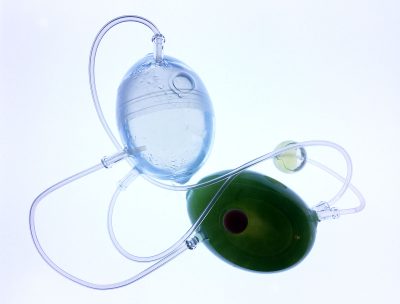

Together with the biophysics lab at VU Amsterdam, AnneMarie Maes developed a biotech/artistic device that is producing algal biomass and that can sense airborne pollution around the outside of the Intelligent Guerrilla Beehive. The hybrid device is still experimental, a proof of concept, and its organic design is an integral part of the Intelligent Guerrilla Beehive installation. During the R&D a range of objects and artifacts based upon qualities of algae were produced.
The methodology used for this project comprises a scientific part (the research) and an artistic part (the production and presentation). The scientific research of the project Sensorial Skin [for an Intelligent Beehive] focuses on a specific aspect of the beehive, namely turn the skin (or outer shell) into a biosensor. I believe that working with cyanobacteria is a promising path to achieve the objectives regarding the responsive skin, because cyanobacteria are auto-trophe and they can live in colonies and react as such. They are able to obtain energy through photosynthesis (a process which converts light energy into chemical energy which can be transformed into electrical energy) and because they can change their internal (and hence external) state based on the degrees of atmospheric pollution that causes them stress. Therefore, I started to study a selection of cyanobacteria species at the Hybrid Forms Lab. I followed a preconceived outline of scientific and artistic procedures.
Important steps in my scientific research were: (1) the choice which bacteria species are used as the basis for photosynthesis, (2) the choice of the growth medium for the bacteria, (3) the choice of the exoskeleton, (4) the mechanisms for converting the captured energy into electrical energy, and (5) the environmental properties that can be sensed directly by the cover shield.

(left) DIY Bioreactor 1.0 at the exhibition ‘Seeing Together’, KASK, School of Arts Ghent, Belgium.©AnneMarie Maes
. (upper right): SEM microscopy of cyanobacterium Anabaena sp. (Collection D.Kunkel Microscopy);
(right) and (bottom right): L’Origine du Monde (bacterial chain), STARTS residencies event, le 104, Paris.
(1): Choice of cyanobacteria: By studying the scientific literature, I discovered that most cyanobacteria species have the tendency to form bacterial chains [Fig.3]. This is an important property to aggregate into colonies and form a biofilm, and moreover, the visual aspect of these chains is also very aesthetic. I selected some strains of cyanobacteria and I started to culture them in the lab. I designed a DIY bioreactor [Fig.4] to monitor closely the behaviour of the bacteria and to check at regular intervals their parameters of growth.
(2) Choice of growth medium: I cultured different strains of cyanobacteria on a selection of nutrient mediums. I examined the ability of these unicellular organisms to aggregate in colonies and thus form biofilms to create a shield around the beehive.
(3) Choice of exoskeleton: I set up experiments to grow biofilms of cyanobacteria on an exoskeleton made of microbial cellulose, one of the materials I work with on the outer shell of the beehive.
(4) Mechanism for converting energy: I measured current flows between positive charged agarose medium saturated with cyanobacteria and negative charged microbial skin overgrown by cyanobacteria.
(5) Environmental properties that can be sensed by the biosensor/biofilm: literature about this point was consulted extensively but this topic then required more practical research in the laboratory; e.g. to find out which airborne pollutants or toxins can be sensed by the cyanobacteria in the biofilm and how exactly they can measure the quantities of these specific substances in the environment?
Important steps in my artistic research were: (1) transfer of the concept/message (2) best possible artistic visualisation (3) the right choice of materials to work with.
(1) Concept: For the past decade I have been researching and carrying out art projects to raise ecological awareness and thus induce behaviour change by the public at large. The Sensorial Skin, created by cyanobacteria, is a living biological interface, a CO2 reducer and a providor of oxygen. With the artwork ‘L’Origine du Monde’ I want to trigger the interest of the public and point to the amazing role cyanobacteria played and still play in the development of our oxygenetic planet.
(2) Artistic discipline: to exhibit the artwork, I choose to work with the form of an installation. The formal aesthetics of the work are inspired by cyanobacterial micrographs made with the Scanning Electron Microscope [Fig.3 upper right]. I also decided to focus on the process/progress of the living organisms during the duration of the exhibition. As the bacterial colonies grow, their colors in the glass vessels become more dense. The air bubbles in the medium manifests the oxygen released by the bacteria.
(3) Disciplines and materials used in the installation: the installation shows a contrast of hard materials (glass, metal) and soft, living, colorful materials (the cyanobacterial colonies). I work with a combination of traditional craftmanship (handmade borosilicate glass vessels, created after my design by artisans in Venice and Brussels and presented on polished black metal sheets) combined with living, biological matter and a selection of different growth mediums with nutrients.
2020: Lichen Research (Kilpisjärvi Fieldstation, Finland / Certosa, Venezia / Brussels)
Besides cyanobacteria, I study the possibility to work with other organisms for sensing the environment. One of these organisms that is worth exploring is lichen. In this context, I am especially looking into the mutualistic relation between cyanobacteria and lichen, and if they can grow as a Sensorial Skin around the beehive.
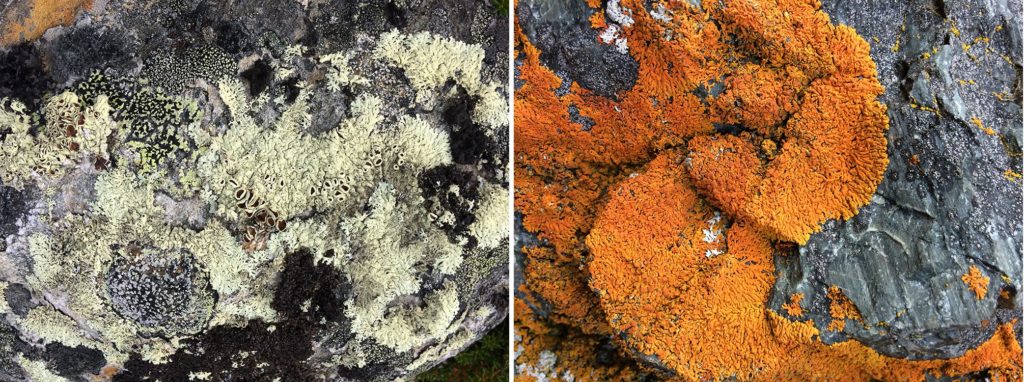
Ecology of the Senses, workshop at the Bio-art Society Finland. Different kind of Lichen photographed around the fieldstation of the University of Helsinki in Kilpisjärvi, Lapland (2018).
Lichen, a symbiotic cohabitation of cyanobacteria and fungi, is a composite organism that emerges from cyanobacteria living among the filaments of the fungi in a mutually beneficial symbiotic relationship. The fungi benefit from the carbohydrates produced by the cyanobacteria via photosynthesis, and the cyanobacteria assure their need for a humid environment through the proximity of the fungi. This cohabitation and collaboration is intriguing. Lichen reacts to sulphur dioxide and acid rain, ozone and nitrogen compounds, fluorides (a side effect of aluminium and glass making and production of fertilisers), toxic aromatic hydrocarbons, metals, and radioactive elements. The effects of these reactions are visible through changes in colour or texture of the lichen and could therefore potentially be used. Lichen can be integrated in the exoskeleton or in the medium. On a regular basis I do fieldwork to collect samples of lichen and cyanobacteria in wet environments around the existing beehives and take them for in-depth study into my lab. In the wet lab of the Hybrid Form Lab Amsterdam / Erasmus BioLab Brussels I studied the samples and was growing the lichen-samples with a variety of micro-algae/cyanobacteria on different growth mediums. The goal is to work very closely with the scientists in the labs.
